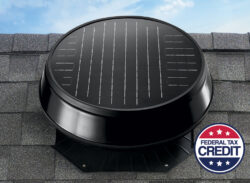Attic Fans: How Can They Help Prevent Mold?
Attic fans can play a crucial role in preventing mold growth during the winter by addressing specific factors that contribute to mold development in attics.
Here’s how an attic fan can help prevent mold in winter:

Moisture Removal:
Attic fans actively remove excess moisture from the attic space. During winter, condensation can occur when warm indoor air rises to the cooler attic and meets cold surfaces. By promoting air circulation, attic fans help prevent moisture buildup, reducing the conditions favorable for mold growth.
Ventilation Enhancement:
Inadequate ventilation in the attic can lead to stagnant air, trapping moisture and creating an environment conducive to mold. Attic fans improve ventilation by expelling humid air and drawing in fresh, dry air from outside. This constant airflow minimizes the likelihood of mold formation.
Condensation Control:
Cold surfaces in the attic, such as rafters and sheathing, can attract condensation during winter. Attic fans assist in controlling condensation by maintaining more uniform temperatures. By preventing temperature differentials, attic fans reduce the risk of moisture accumulation and subsequent mold growth.
Preventing Mold on Roofing Materials:
Mold can develop on roofing materials if moisture is present. Attic fans contribute to preventing mold on these surfaces by keeping the attic environment dry and well-ventilated. This is particularly important for the underside of the roof where mold can impact the longevity of roofing materials.
Year-Round Moisture Management:
Attic fans designed for year-round operation can effectively manage moisture throughout the winter. These fans can be programmed to operate based on humidity levels, ensuring continuous prevention of mold growth even in colder months.
Preserving Attic Insulation:
Attic insulation can harbor moisture if not properly ventilated. A Attic fan will aid in preserving insulation by reducing humidity levels and preventing moisture accumulation. This, in turn, helps mitigate the risk of mold growth within the insulation material.
Reducing Mold Spore Spread:
By maintaining a dry and well-ventilated attic, attic fans contribute to reducing the overall moisture content in the home. This minimizes the potential for mold spores to spread from the attic to other areas of the house through the air circulation system.
Healthy Indoor Air Quality:
Preventing mold growth in the attic positively impacts indoor air quality. Mold spores released into the air can have adverse effects on respiratory health, and an attic fan helps minimize the likelihood of these spores entering the living spaces.
Regular monitoring of the attic space, prompt identification of any water leaks or issues, and ensuring proper attic fan operation are key elements in preventing mold growth during the winter months.
